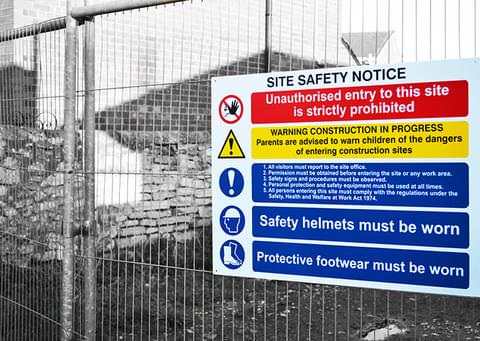
Employers must provide safety signs if there is a significant risk that can’t be avoided or controlled in any other way, such as through safe systems of work or engineering controls.
Safety Signs are part of the hierarchy of controls at work, with PPE always being the last line of defence.
To conform with European legislation, all safety signs must comply with the Health and Safety (Safety Signs & Signals) Regulations 1996.
The Regulations enact in UK law an EU Directive designed to harmonise signs across the EU so that signs across the member states will have the same meaning in whichever country they are used in.
There is no need to provide safety signs if they don’t help reduce the risk or if the risk isn’t significant. This applies to all places and activities where people are employed. Where necessary, employers MUST:
• use road traffic signs in workplaces to regulate road traffic.
• maintain the safety signs they provide.
• explain unfamiliar signs to their employees and tell them what they need to do when they see safety signs.
All safety signs should be clear, legible, well-maintained, and visibly placed. While most safety signs are self-explanatory, it is important to ensure that all employees are aware of what safety signs mean, which may require staff training.
Shape & Colour: Yellow triangle with black border
Meaning: Potential hazard within a designated area, Caution/Risk of Danger.
Shape & Colour: Red Circle with diagonal line
Meaning: You must not/do not do/stop.
Shape & Colour: Solid green rectangle or square
Meaning: The safe way/where to go in an emergency.
Shape & Colour: Solid red rectangle or square
Meaning: Locates fire equipment or personnel.
Shape & Colour: Solid blue circle
Meaning: You must do/carry out action displayed on sign.
With all these signs, supplementary text may be added if necessary to convey a clearer message.
The BS EN ISO 7010 regulation adopted European Safety Signs Directive (92/58/EEC), which outlines the correct layout for safety signs across the EU.
The relevant points state that employers are required to:
• Identify all fire exits, fire alarms and firefighting equipment with pictogram signs.
• Utilise safety signs to limit risk to hazards (not avoided or controlled by other measures) identified with the risk assessment.
• Maintain safety signs, ensuring they are legible, up to date and remain relevant to the hazard.
• Explain unfamiliar signs to their employees and tell them what they need to do when they see a safety sign.
• The Regulations apply to all places and activities where people are employed.